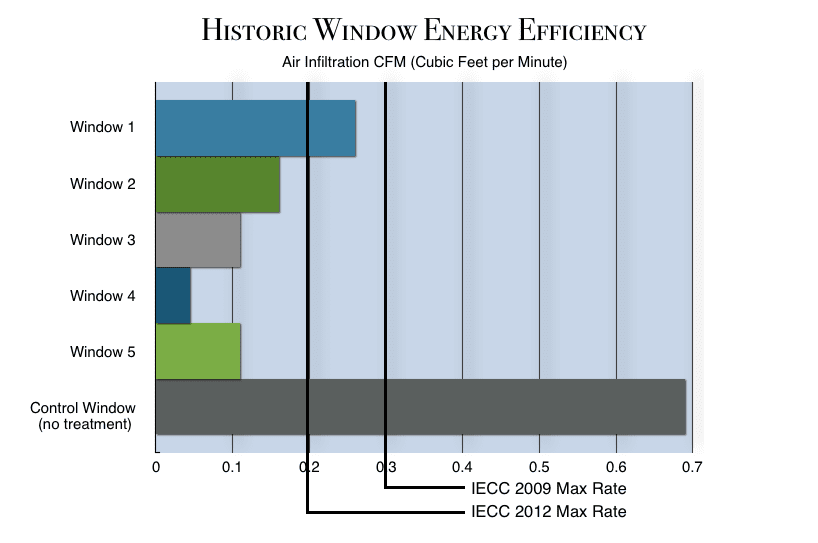Energy-Efficient Historic Windows:
Fact, Not Fiction
An energy-efficient historic window isn’t a lie—it’s a practical reality. With simple, affordable upgrades, original wood and steel windows can be made just as, if not more, energy-efficient than modern replacement windows at a fraction of the cost. Every single historic window can be repaired and weatherstripped to outperform most new models.
The reason this matters so much is that historic windows are disappearing at an alarming rate—over 30 million are ripped out and discarded each year in the name of "energy efficiency." This creates unnecessary waste and strain on landfills, all while sacrificing irreplaceable craftsmanship and old growth lumber.
The Replacement Window Industry's Dirty Tricks
The replacement window industry knows exactly what they’re doing. They have thoroughly tested their products and understand exactly how they perform. Their products are designed to fail over time, but they market them as energy-saving because even a poorly maintained historic window will naturally lose efficiency. Of course, almost anything—including a sheet of plywood—would outperform a neglected window. But a properly restored and weatherstripped original window can save more energy over its lifetime than any replacement window.
Step 1: They Create the Problem
The industry convinces you that your drafty, high-maintenance windows are costing you time and money—the two most effective marketing triggers.
Step 2: They Offer a Simple Solution
They promise that replacing your windows will lower energy bills and eliminate maintenance. Sounds perfect, right? Wrong.
Step 3: The "Lifetime" Warranty Trap
Most replacement windows come with a “lifetime warranty”—but here’s the catch: The glass is usually only covered for 10 to 20 years, and labor is only covered for two years. Even worse, these warranties are non-transferable. When you move (which happens every 6.5 years on average), the warranty disappears, setting up the next owner for expensive replacements.
The Proof: Historic Windows Can Outperform Replacements
In 2011, the Window Preservation Standards Collaborative conducted third-party testing to measure the energy efficiency of restored historic windows. Five different upgrade methods were tested, and every single one exceeded the 2009 energy code requirements—most even beat the stricter 2012 standards.
Test Results:
Window 1: Restored + exterior wood storm window → exceeded 2009 IECC
Window 2: Restored + metal weatherstripping + exterior storm window → exceeded 2012 IECC
Window 3: Restored + metal weatherstripping + exterior metal storm → exceeded 2012 IECC
Window 4: Restored + rubber bulb weatherstripping → exceeded 2012 IECC
Window 5: Not restored + site-made interior storm → exceeded 2009 IECC
Control Window: No upgrades → failed both codes
Unlike replacements, historic windows don’t need warranties—they’ve already lasted 80 to 120 years and will continue to do so with minimal maintenance. Why replace what’s already built to last? If that’s not enough reason…
Dade County Pine is the strongest lumber ever grown.
Dade County Pine, scientifically known as Pinus elliottii var. densa, is renowned for its exceptional strength, density, and durability, making it one of the strongest lumbers ever utilized in construction. This subspecies of slash pine is native to South Florida and the Florida Keys, thriving in the unique pine rockland ecosystems.
Key Characteristics Contributing to Its Strength:
High Density and Strength: Dade County Pine is notably dense and strong, closely resembling Longleaf Heart Pine in appearance but often exhibiting a denser and more intricate grain pattern.
Resistance to Decay and Insects: The wood's high density and reduced sapwood content make it highly resistant to decay and insect damage, including termites. This resistance is attributed to its tight growth rings and minimal sapwood, which insects typically feed on.
Durability in Harsh Conditions: Structures built with Dade County Pine have withstood numerous hurricanes and the test of time, with many historic buildings in South Florida still standing after more than a century.
Due to overharvesting in the 19th and early 20th centuries, old-growth Dade County Pine became scarce and is now protected, making it unavailable for commercial logging. Today, this prized wood is primarily sourced through salvage operations from historic structures, preserving its legacy and continued appreciation in woodworking and construction.
The unique combination of high density, exceptional strength, and natural resistance to decay and pests solidifies Dade County Pine's reputation as one of the strongest and most durable lumbers ever utilized.
I don’t have proof of this, but lately I’ve been wondering if insurance conglomerates don’t have business interests in window manufacturing companies. We have 3 insurance companies left, 1 state backed and two private. Our windows have survived 100 years already. It won’t be long until the insurance cos. have packed up and left Florida with a state full of crappy windows that don’t open.
I drove down Old Cutler on a 70 degree day in February, and EVERY window was hermetically sealed shut. Not one home had an open window. (They all had been replaced in the name of energy efficiency and hurricane safety.) The further we remove ourselves from nature and our neighbors, the more unhappy we will become.
